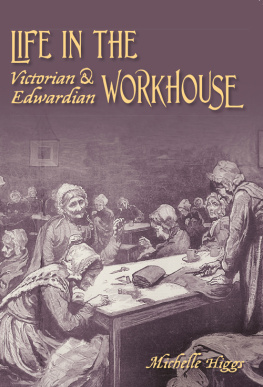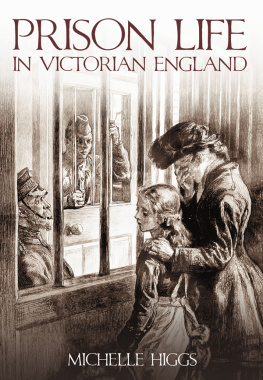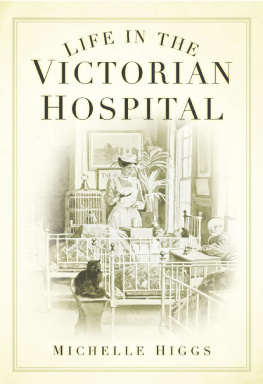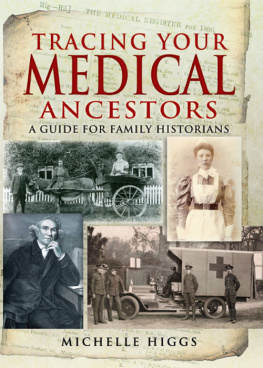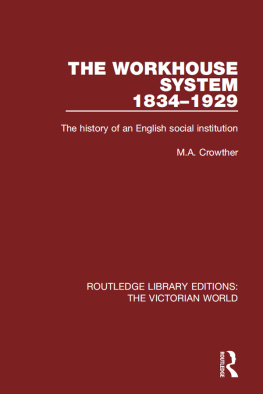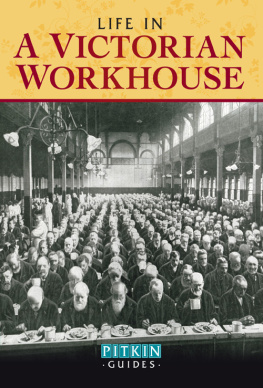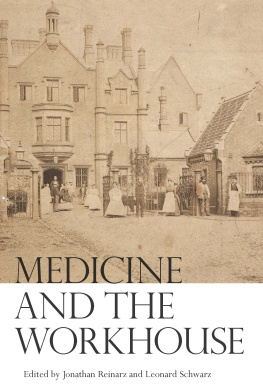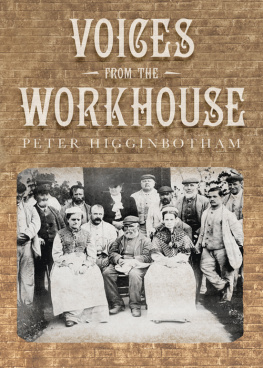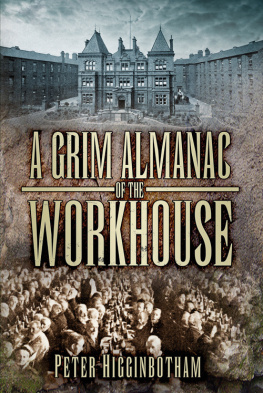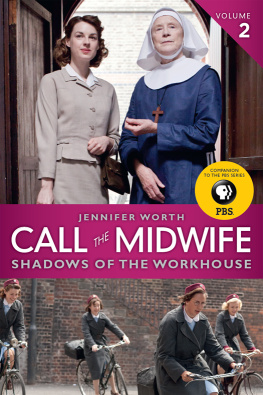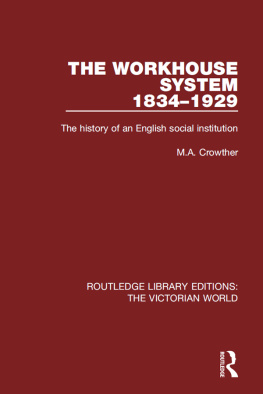

While writing this book, I received help and encouragement in locating information and illustrations from a number of different sources and institutions. I would like to express my gratitude to the following:
The staff of Dudley Archives, Durham County Record Office and Ceredigion Record Office; the Northern General Hospital History Project, Sheffield; the Sheffield Teaching Hospitals NHS Foundation Trust; Mike Spick at the Sheffield Local Studies Library; Frances Collinson at the Gressenhall Farm and Workhouse The Museum of Norfolk Life; Philip Bye of the East Sussex Record Office; Elaine Fisher at the Slough Museum; Paul Johnson and Tim Padfield at the National Archives; Elizabeth Green of Hackney Archives; Dr Paul Davies; Margaret Towler; Ian Beach; Lisa Robinson; Ann Gray; Derek George and Judith Hawkins.
Thanks are also due to Kevin Towers of the West London Mental Health NHS Trust for granting permission to publish information from the records of Alfred Woodhurst; Lyn Howsam of the Northern General History Project for being so generous with her time and research; Chris Sanham for sharing information from the Maria Rye Children Database 1868-1896 and John Sayers for his research on specific home children in Canada.
I would also like to express my thanks to the following people, who generously shared their research about their ancestors and without whose help this book would be the poorer:
Mari Ambrose; Jill Barrett; Phil Bristow; Benjamin Caine; Harry E. Clarke; Wilfred William Ellesmore; Roger Harpin; Carl Higgs; Christopher J. Hogger; Judith Holmes; Bruce Isted; Maud Jarvis; Derek Jenkins, Barbara Towle, Richard Robinson and Joy Bedson; Sheila Kirk; Colin Leathley; Pat McGrath; Yvonne Moore; Sandy Norman; Lynn Nugent and Norma Robinson; Edwin Pickett; Ruth Piggott; Ken Ripper; Alan Tweedale and Janette Woodhead.
Thanks are also due to the late Margaret Twelvetree for sharing her memories of Pontefract and Stratford-on-Avon Union Workhouses; and to the late Maurice Cuerton for his research about his ancestor Charles Cuerton, and to his widow Marie for granting permission to publish the information.
Finally, I would like to thank my husband Carl for his unfailing love and support, and my family and friends for their encouragement during the writing of this book.
ILLUSTRATIONS
Every effort has been made to trace the copyright holders of images included in this book. The publishers would be grateful for further information concerning any image for which we have been unable to trace a copyright holder.
C ONTENTS
In the nineteenth and early twentieth centuries, generations of working-class families lived in fear of the workhouse, variously called the union, the bastille, the spike or simply the house. This fear has become such an integral part of workhouse mythology that it is sometimes difficult to separate fact from fiction. Which is the more accurate representation of the average Victorian workhouse? The horrific conditions of the workhouse in which poor Oliver Twist stayed, or the well-run example at Wapping which Dickens visited in 1860?
What was life really like in a workhouse, either as an inmate or a member of staff? This book aims to identify the types of people who entered the workhouse and their reasons for doing so, their living conditions and diet, the work they had to undertake and to look into their monotonous day-to-day routine. It will also describe the roles of the different members of staff, the conditions they worked and lived in, and their reasons for becoming workhouse officers.
By piecing together the available evidence from workhouse records and regulations, censuses, dietary tables, workhouse plans and local studies, it is possible to build up a picture of workhouse life. This will always be slightly out of focus as records are missing or incomplete and direct evidence from inmates and staff, in the form of letters and testimony, is rare.
While undertaking research for this book, a small, at first seemingly insignificant, detail was found. Although the inmates and staff of all workhouses were recorded in the national censuses, anyone trying to locate their ancestors in Dudley Union Workhouse on the 1861 census is faced with an immediate problem. The enumerator carefully named all the members of staff in the workhouse but recorded the inmates simply with initials. No first or last names are given.
It is not known if this method of recording was at the instigation of the workhouse master or whether the decision was taken by the enumerator himself. However, it could be interpreted in two ways. There was a real stigma attached to being a workhouse inmate. Recording the inmates with initials could be evidence of a compassionate workhouse master or enumerator, trying to preserve the anonymity of the inmates. Alternatively, it might also be evidence that the inmates were viewed as simply initials in a register, not worthy of a full identity.
Whichever interpretation is correct, in other censuses researched, the names of inmates are given in full. This is just one example which illustrates that the running of workhouses varied throughout the country because they were run at a local level. No two workhouses were ever exactly alike. As a result, the experience of workhouse life for both inmates and staff differed widely across England and Wales.
N OTES
. Crowther, M.A., The Workhouse System 1834-1929 , (1981), p3
. Ibid. , p6
. 1861 Census, Sedgley, RG 9/2046 E.D. 11
. Crowther, op. cit. , p5
In November 1836, a most daring attempt was made to murder Richard Ellis, the master of Abingdon Union Workhouse. Shots were fired from the workhouse garden through the sitting-room window, narrowly missing the masters sister and an elderly pauper. Abingdon was the first of a new breed of workhouse built as a result of the Poor Law Amendment Act of 1834. The workhouse had been open for inmates for about a month and it was believed that the violent attack against the master was a protest against the new Poor Law legislation.
Before 1834, each parish was responsible for its own poor. The able-bodied who had fallen on hard times or were unemployed, for whatever reason, could expect to be granted outdoor relief from the parish overseer of the poor in his or her own home. The sick and elderly might also be looked after in a small parish workhouse which was seen as a relatively unthreatening and even friendly institution.
THE NEW POOR LAW IN ACTION
After 1834, there were four main changes to the Poor Law system. Firstly, a central authority, called the Poor Law Commission, was to regulate the new Poor Law. The Poor Law Commission, based in London, was made up of three commissioners who had the power to issue rules and regulations for the new Poor Law. They were supported in their role by assistant commissioners. (From 1847, responsibility for the Poor Law passed to the Poor Law Board. After 1871, the Poor Law was administered by the Local Government Board.)
Secondly, parishes were to group together into unions to benefit from economies of scale. It was proposed that approximately thirty parishes join together to create each new union. Each union was to be run by a board of guardians which would meet weekly and report regularly to the Commission. It was the responsibility of the assistant commissioners to oversee the setting up of the new unions. However, it was no easy matter to obtain agreement from each parish, and those parishes which had joined together under earlier legislation known as the Gilbert Act often refused to be brought into the new system.
Next page
